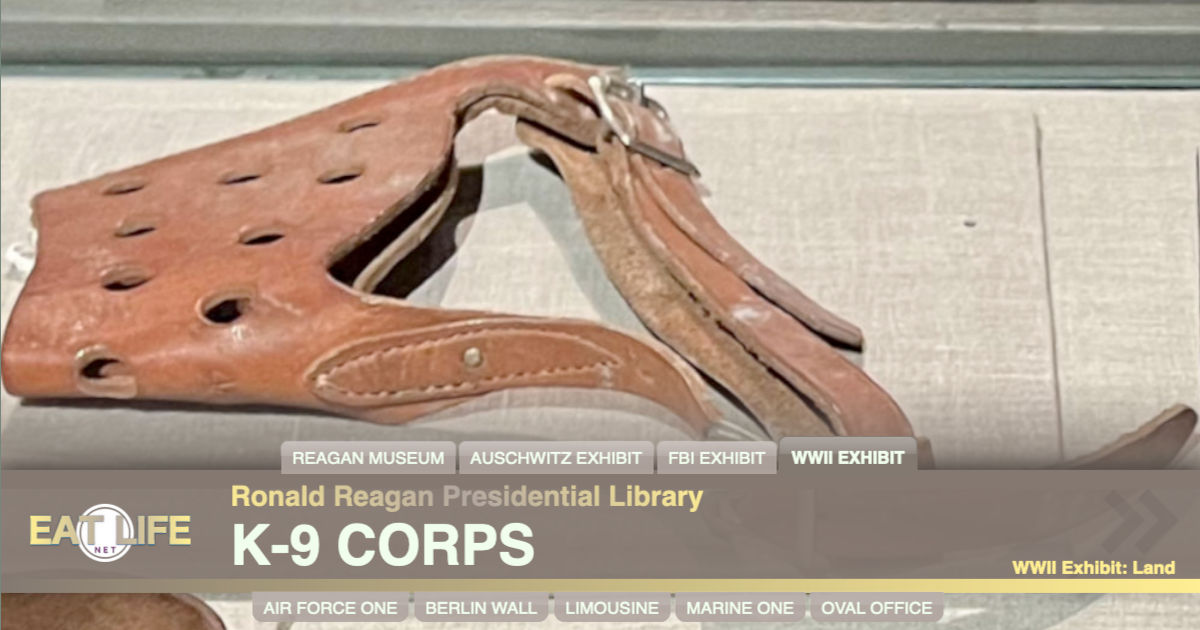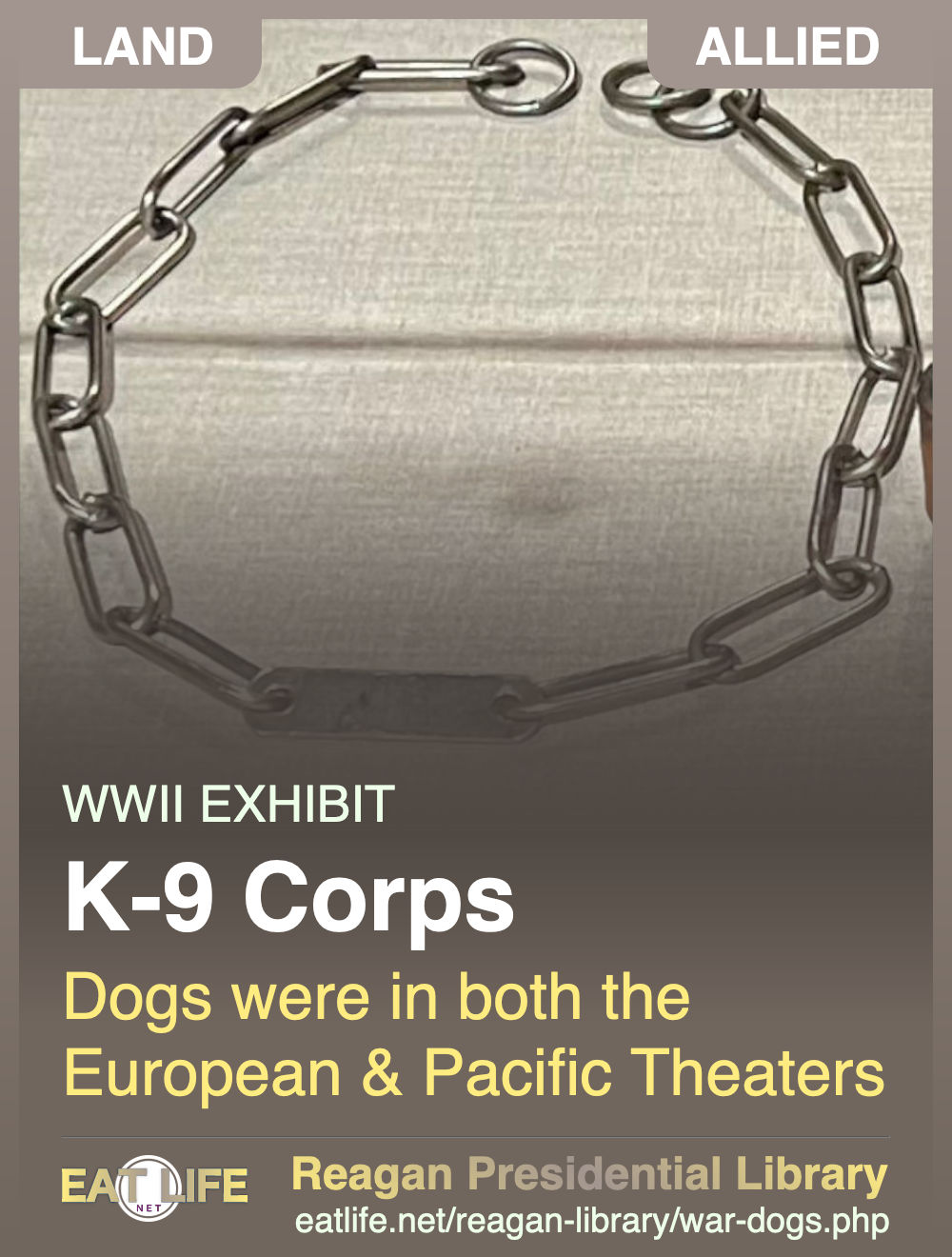World War II had a K9 corps with a training program for dogs. Dogs were trained as guard, scout, sentry, messenger, mine, or sled dogs. People donated their pet dogs to the war effort. Over 18,000 dogs reported to the camps, but many were unsuitable for military tasks. They ended up limiting it to only German Shepherds, Doberman Pinchers, Belgian Sheep Dogs, Siberian Huskies, Collies, Eskimo dogs, or Malamutes.
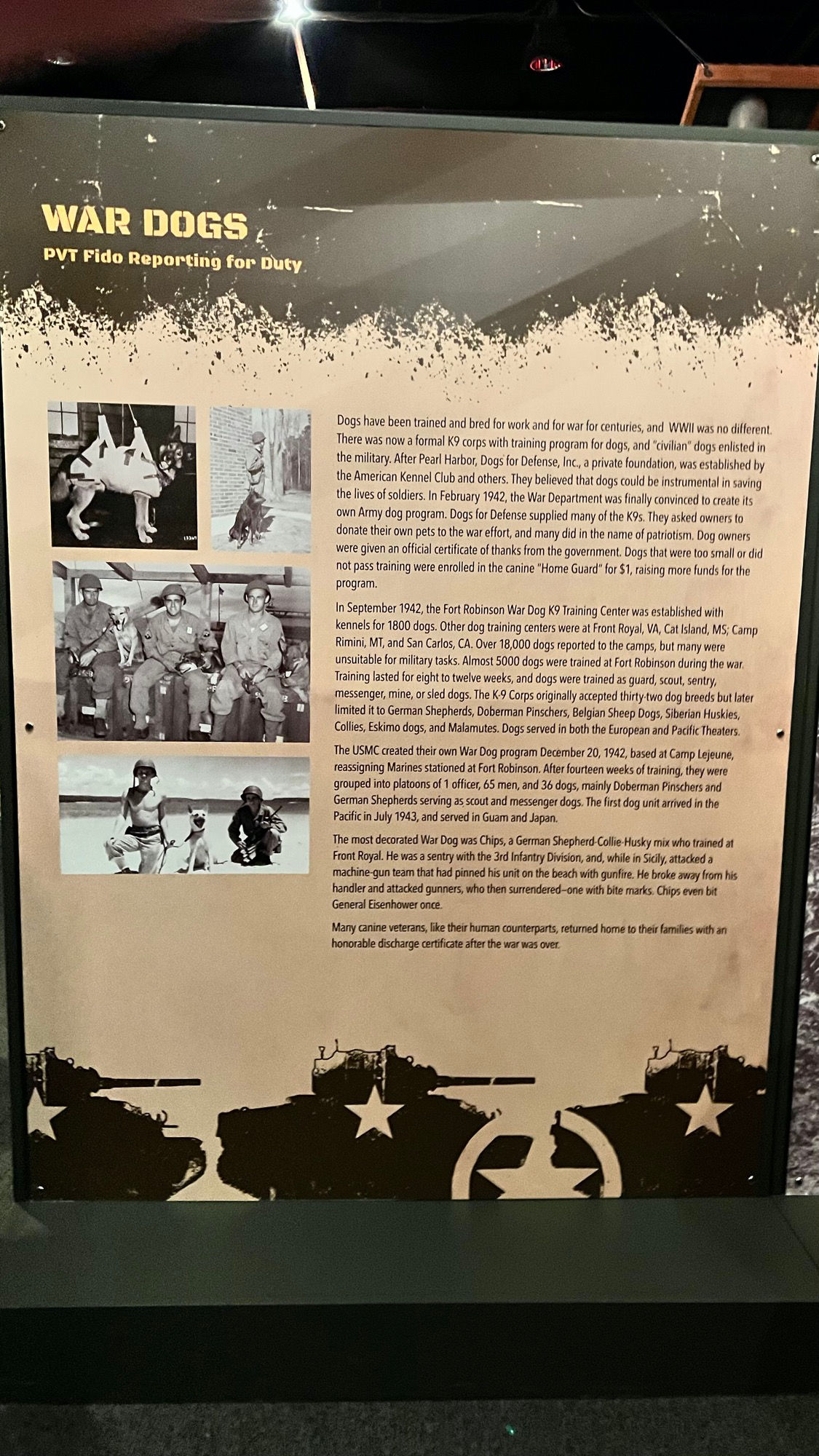
PVT Fido Reporting for Duty
Dogs have been trained and bred for work and for war for centuries, and WWIl was no different. There was now a formal K9 corps with training program for dogs, and "civilian" dogs enlisted in the military.
After Pearl Harbor, Dogs for Defense, Inc., a private foundation, was established by the American Kennel Club and others. They believed that dogs could be instrumental in saving the lives of soldiers. In February 1942, the War Department was finally convinced to create its own Army dog program. Dogs for Defense supplied many of the K9s. They asked owners to donate their own pets to the war effort, and many did in the name of patriotism. Dog owners were given an official certificate of thanks from the government. Dogs that were too small or did not pass training were enrolled in the canine "Home Guard" for $1, raising more funds for the program.
In September 1942, the Fort Robinson War Dog K9 Training Center was established with kennels for 1800 dogs. Other dog training centers were at Front Royal, VA, Cat Island, MS, Camp Rimini, MT, and San Carlos, CA. Over 18,000 dogs reported to the camps, but many were unsuitable for military tasks. Almost 5000 dogs were trained at Fort Robinson during the war. Training lasted for eight to twelve weeks, and dogs were trained as guard, scout, sentry, messenger, mine, or sled dogs.
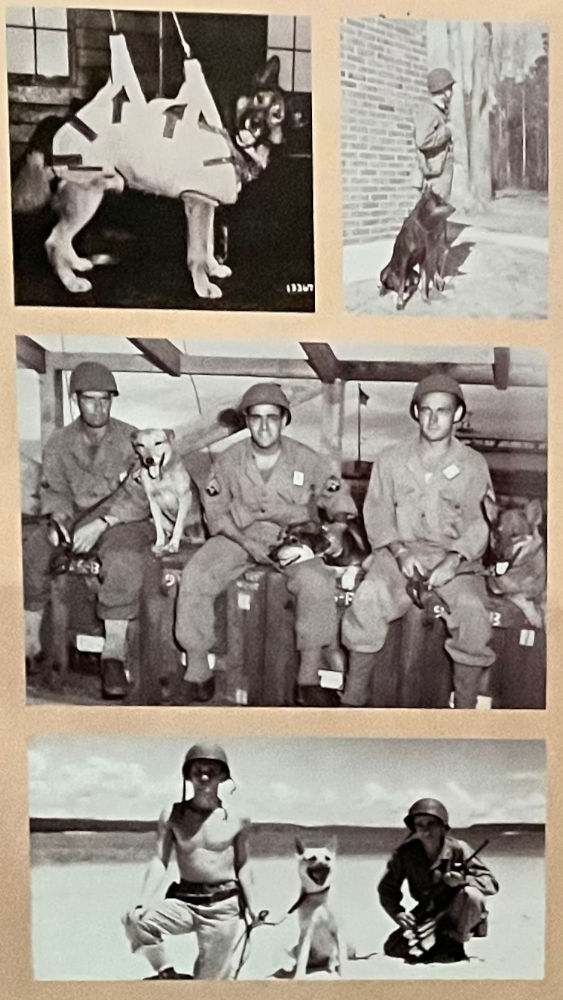 The K-9 Corps originally accepted thirty two dog breeds but later limited it to German Shepherds, Doberman Pinchers, Belgian Sheep Dogs, Siberian Huskies, Collies, Eskimo dogs, and Malamutes.
Dogs served in both the European and Pacific Theaters.
The K-9 Corps originally accepted thirty two dog breeds but later limited it to German Shepherds, Doberman Pinchers, Belgian Sheep Dogs, Siberian Huskies, Collies, Eskimo dogs, and Malamutes.
Dogs served in both the European and Pacific Theaters.
The USMC created their own War Dog program December 20, 1942, based at Camp Lejeune, reassigning Marines stationed at Fort Robinson. After fourteen weeks of training, they were grouped into platoons of 1 officer, 65 men, and 36 dogs, mainly Doberman Pinschers and German Shepherds serving as scout and messenger dogs.
The first dog unit arrived in the Pacific in July 1943, and served in Guam and Japan. The most decorated War Dog was Chips, a German Shepherd Collie / Husky mix who trained at Front Royal. He was a sentry with the 3rd Infantry Division, and, while in Sicily, attacked a machine-gun team that had pinned his unit on the beach with gunfire. He broke away from his handler and attacked gunners, who then surrendered one with bite marks. Chips even bit General Eisenhower once.
Many canine veterans, like their human counterparts, returned home to their families with an honorable discharge certificate after the war was over.
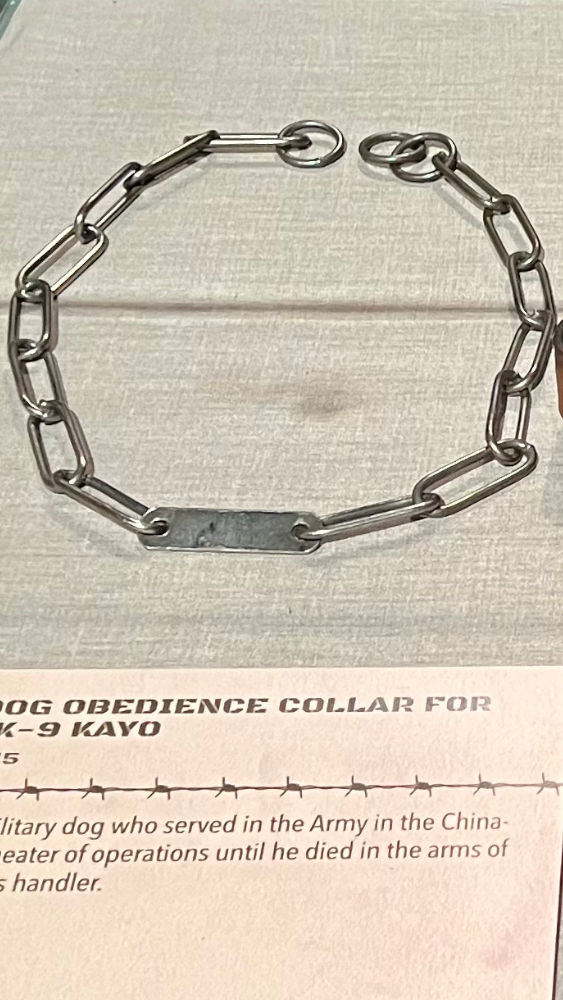
Army K-9 Kayo
Kayo was a military dog who served in the Army in the China-Burma-India theater of operations until he died in the arms of Richard Zika, his handler.
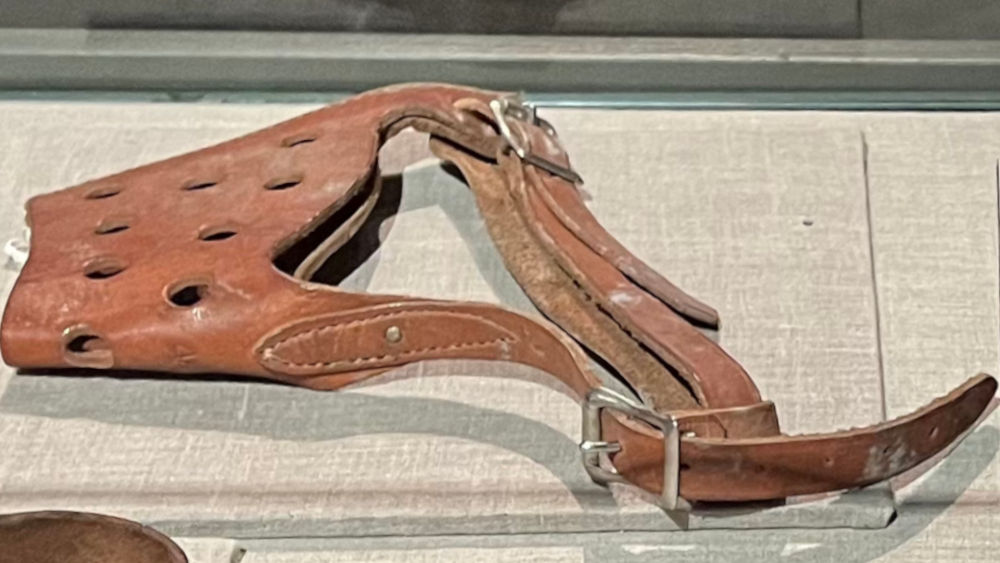
Army K-9 Messenger Dog
This collar and muzzle were typical of the pieces used at Fort Robinson during the dog's training. The dog collar has a pouch on it to carry messages.
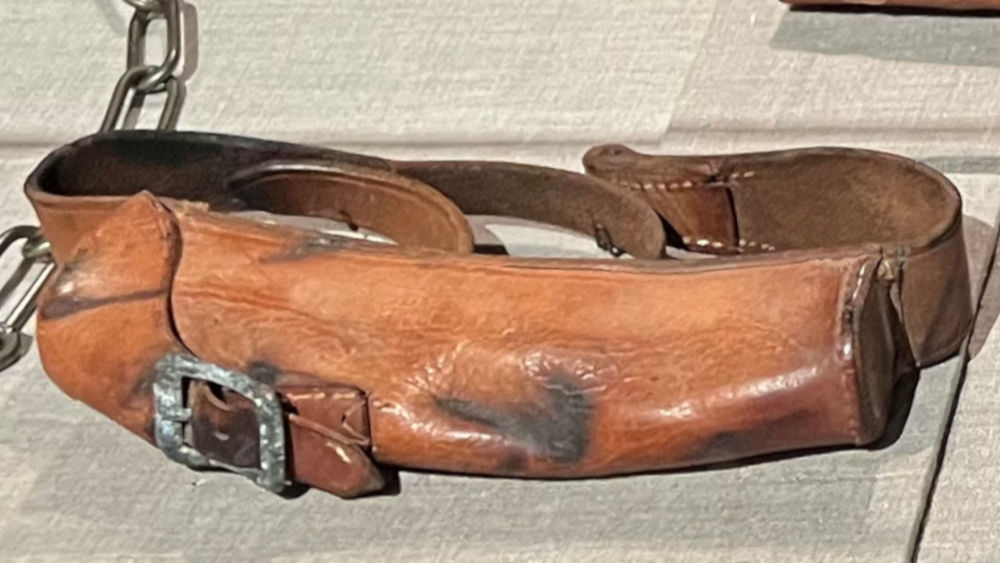
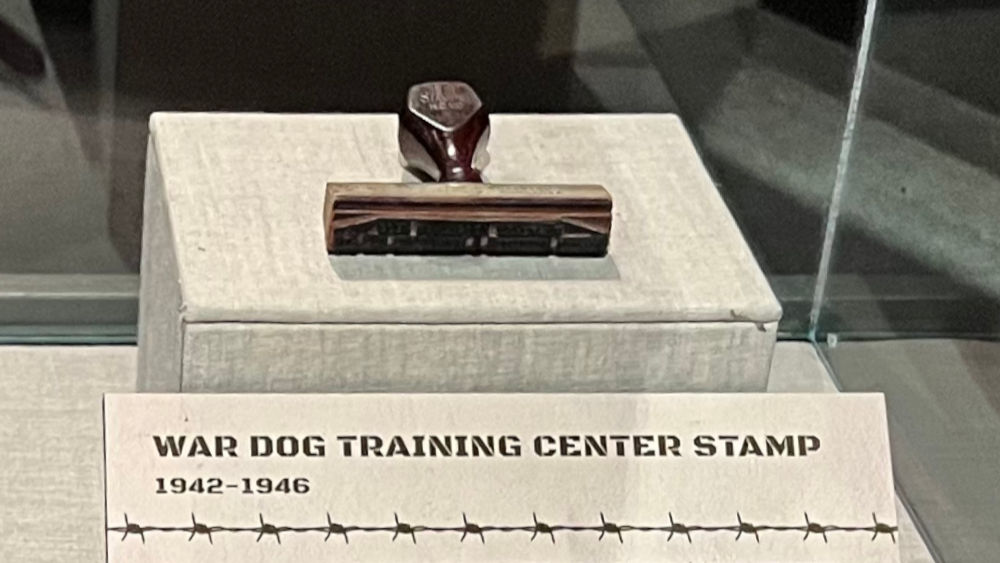
The stamp reads "WAR DOG RECEPTION & TRAINING CENTER FORT ROBINSON, NEBRASKA". It belonged to Donald L. Stuber who served as a dog trainer and supply sergeant at Fort Robinson.
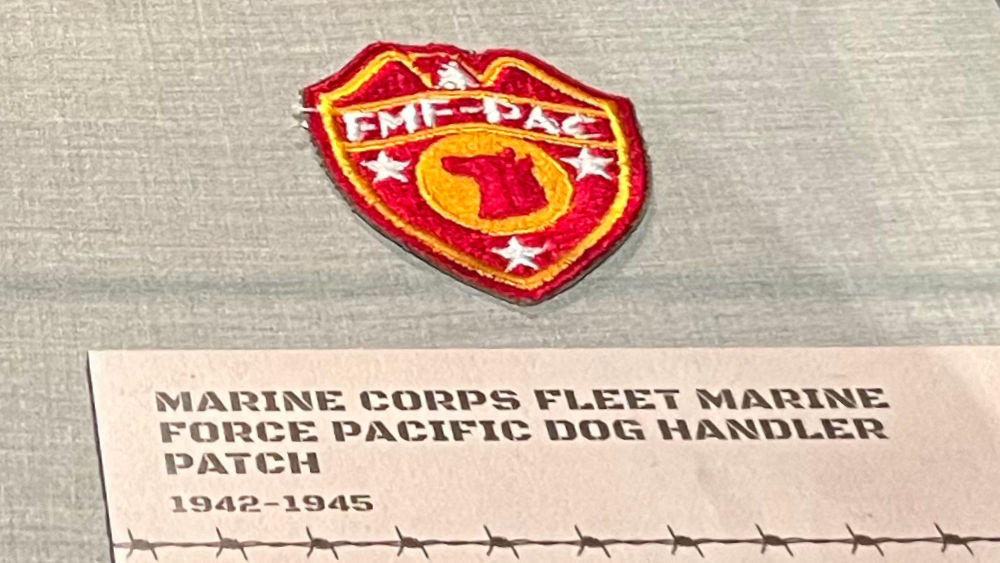
Marine Corps Fleet Marine Force Pacific Dog Handler Patch
The Fleet Marine Force Pacific (FMFPac) was established in 1944 to oversee USMC forces in the Pacific theater. The dog handler patch was an FMFPac patch with the center star insignia replaced with a silhouette of a dog's head.
WikipediaDogs in warfare have a very long history starting in ancient times. From being trained in combat, to their use as scouts, sentries, messengers, mercy dogs, and trackers, their uses have been varied and some continue to exist in modern military usage.War dogs were used by the Egyptians, Greeks, Persians, Sarmatians, Baganda, Alans, Slavs, Britons, and Romans.
Dogs have been used in warfare by many civilizations. As warfare has progressed, their purposes have changed greatly.
TIMELINE: DOGS IN WAREFARE 750 BC In the war waged by the Ephesians against Magnesia on the Maeander, their horsemen were each accompanied by a war dog and a spear-bearing attendant. Dogs were released first and broke the enemy ranks, followed by an assault of spears, then a cavalry charge. An epitaph records the burial of a Magnesian horseman named Hippaemon with his dog Lethargos, his horse, and his spearman. 525 BC At the Battle of Pelusium, Cambyses II used a psychological tactic against the Egyptians, arraying dogs and other animals in the front line to effectively take advantage of the Egyptian religious reverence for animals. 490 BC At the Battle of Marathon, a dog followed his hoplite master into battle against the Persians and was memorialized in a mural. 480 BC Xerxes I of Persia was accompanied by vast packs of Indian hounds when he invaded Greece. They may have served in the military and were possibly being used for sport or hunting, but their purpose is unrecorded. 281 BC Lysimachus was slain during the Battle of Corupedium and his body was discovered preserved on the battlefield and guarded vigilantly by his faithful dog. 231 BC Roman consul Marcus Pomponius Matho led the Roman legions through the inland of Sardinia. The inhabitants engaged in guerrilla warfare, against the invaders. The Romans used "dogs from Italy" to hunt down the natives who tried to hide in the caves. 120 BC Bituito, king of the Arverni, attacked a small force of Romans led by the consul Fabius, using just the dogs he had in his army. 1500s Mastiffs and other large breeds were used extensively by Spanish conquistadors against Native Americans. 1914–1918 Dogs were used by international forces to deliver vital messages. Sergeant Stubby, a Bull Terrier or Boston Terrier, has been called the most decorated war dog of World War I, and the only dog to be nominated for rank and then promoted to sergeant through combat. Recognized in connection with an exhibition at the Smithsonian Institution. Among many other exploits, he's said to have captured a German spy. He also became mascot at Georgetown University. Rags was another notable World War I dog. 1941–1945 The Soviet Union deployed dogs strapped with explosives against invading German tanks, with limited success. 1943–1945 The United States Marine Corps used dogs, donated by their American owners, in the Pacific theater to help take islands back from Japanese occupying forces. During this period, the Doberman Pinscher became the official dog of the USMC; however, all breeds of dogs were eligible to train to be "war dogs of the Pacific". Of the 549 dogs that returned from the war, only four could not be returned to civilian life. Many of the dogs went home with their handlers from the war. Chips was the most decorated war dog during World War II. 1966–1973 About 5,000 US war dogs served in the Vietnam War (the US Army did not retain records prior to 1968); about 10,000 US servicemen served as dog handlers during the war, and the K9 units are estimated to have saved over 10,000 human lives; 232 military working dogs and 295 US servicemen working as dog handlers were killed in action during the war. An estimated 200 Vietnam War dogs survived the war to be assigned to other US bases outside the US. The remaining canines were euthanized or left behind. 2011 United States Navy SEALs used a Belgian Malinois military working dog named Cairo in Operation Neptune Spear, in which Osama bin Laden was killed. 2019 United States 1st SFOD-D operators used a male Belgian Malinois named Conan during the Barisha raid. 2020 According to Democratic senator Richard Blumenthal, US military working dogs should be US breed instead of European. American breeders are said to become a necessity in the near term, Blumenthal said, solely due to increase in demand for the dogs. WIKIPEDIA






